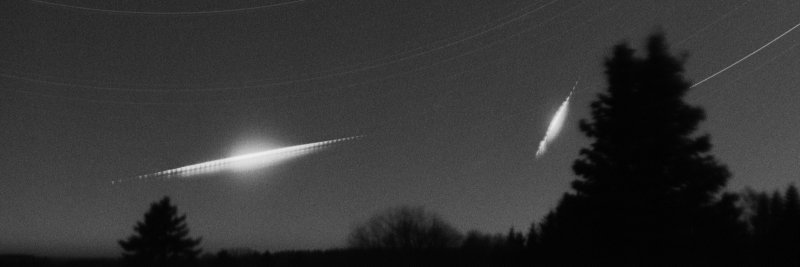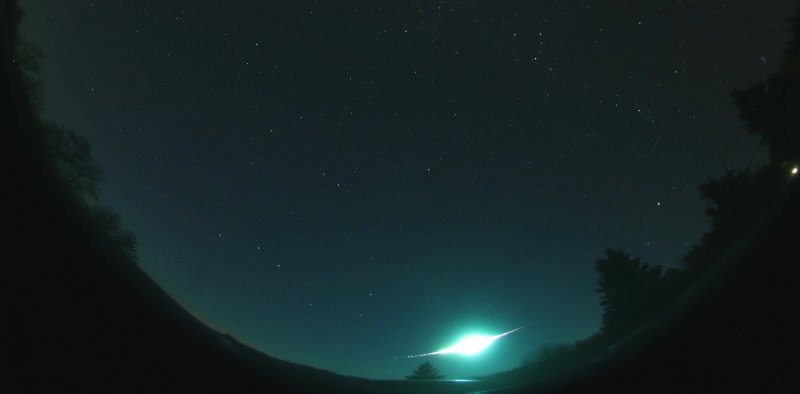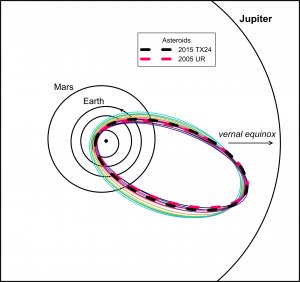A newly discovered branch of the Taurid meteoroid stream contains hazardous asteroids
Press release from 5th June 2017

Detailed analysis of 144 fireballs from the Taurid meteor shower observed by the European Fireball Network in 2015 revealed a well defined orbital structure, which was responsible for the enhanced Taurid activity in that year. Orbit comparison showed that this “new branch” of Taurids contains also at least two asteroids of the size 200 – 300 meters. Since it is very likely that numerous still not discovered objects of decameter or even larger size are present as well, impact hazard increases significantly when the Earth encounters the Taurid new branch every few years
The Taurid meteoroid stream produces at least four meteor showers on Earth: two are active at night from end of September until beginning of December, and two at day from end of May to the middle of July. Although comet 2P/Encke is the most probable parent body of the Taurid stream, it was also proposed that 2P/Encke is just a fragment of a much larger comet, which was disrupted thousands years ago and formed the whole Taurid complex including a number of asteroids. Nevertheless, many of the proposed asteroids may have similar orbits just by chance.
In some years, Taurid activity is higher than usually, especially in terms of large numbers of bright meteors (fireballs). We performed careful analysis of 144 Taurid fireballs observed by new digital autonomous fireball observatories of the European Fireball Network displaced over Czech Republic (at 13 stations), Austria (1 station) and Slovakia (1 station) in 2015, when the activity was enhanced. Orbits of 113 fireballs show common characteristics and form together a well defined orbital structure. The orbits are characterized by longitudes of perihelia lying between 155.9 – 160 degrees and latitudes of perihelia between 4.2 - 5.7 degrees and form a concentric ring in the inner solar system. Semimajor axes are between 2.23 - 2.28 AU and overlap with the 7:2 resonance with Jupiter, as expected from previous work of other authors. The orbits come close together at heliocentric distance of about 3.6 AU, which suggest that the branch could be formed by a disintegration of a large body at the point. The masses of the observed meteoroids were in a wide range from 0.1 gram to more than 1000 kg. We found that all meteoroids larger than 300 grams were very fragile, while those smaller than 30 grams were much more compact.



Fireball data prove the presence of meter-sized bodies among the Taurid new branch. Based on orbital similarity, we argue that asteroids of several hundred meters in diameter are members of the Taurid new branch as well. This is almost certain for asteroid 2015 TX24, very likely for 2005 UR, and possible for 2005 TF50. We are not speaking about a distant relationship. The discovered Taurid branch is simply a population of bodies with the size range from several millimeters to several hundred of meters, which all move together around the Sun. The narrow range of orbital parameters of the new branch makes the association of Taurids with these asteroids much more reliable than it was possible before. Every few years, the Earth is encountering this branch for a period of about three weeks. During that time, the chance of impact of a sizeable asteroid (tens of meters) is significantly enhanced. Even if intrinsically weak, bodies of such size can penetrate deep in the atmosphere and pose a hazard to the ground.
Further studies leading to better description of this real source of potentially hazardous objects, which can be large enough to cause significant regional or even continental damage, are therefore extremely important. Discovery of these dark cometary bodies in space is complicated by their low albedos (the fraction of the total incident solar radiation reflected by a body back to space). Large telescopes and favorable geometric conditions of observations, (i.e. small distance from the Earth and large angular distance from the Sun) are thus needed.
Published in:
Spurný P., Borovička J., Mucke H. and Svoreň J. 2017, Discovery of a new branch of the Taurid meteoroid stream as a real source of potentially hazardous bodies, Astronomy & Astrophysics, in press, DOI 10.1051/0004-6361/201730787
Free access to the article: www.aanda.org/10.1051/0004-6361/201730787
 Contact:
Contact:
Dr. Pavel Spurný and Dr. Jiří Borovička
Interplanetary matter department, Astronomical Institute
Academy of Sciences of the Czech Republic
Address: Fričova 298, CZ-251 65 Ondřejov, Czech Republic
Email: pavel.spurny (at) asu.cas.cz, jiri.borovicka (at) asu.cas.cz
Phone: +420 323 620 153